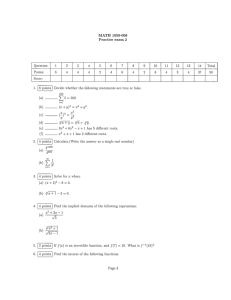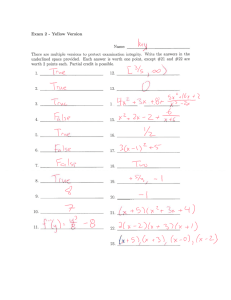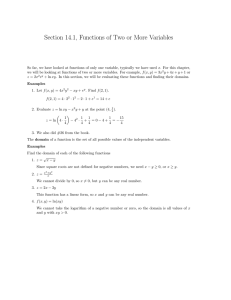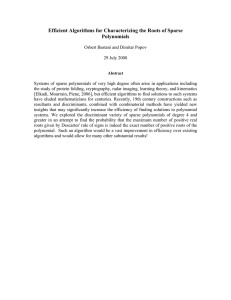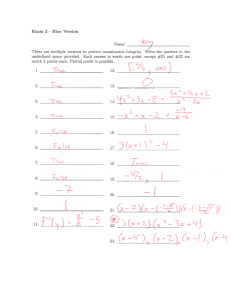Factoring Polynomials
advertisement
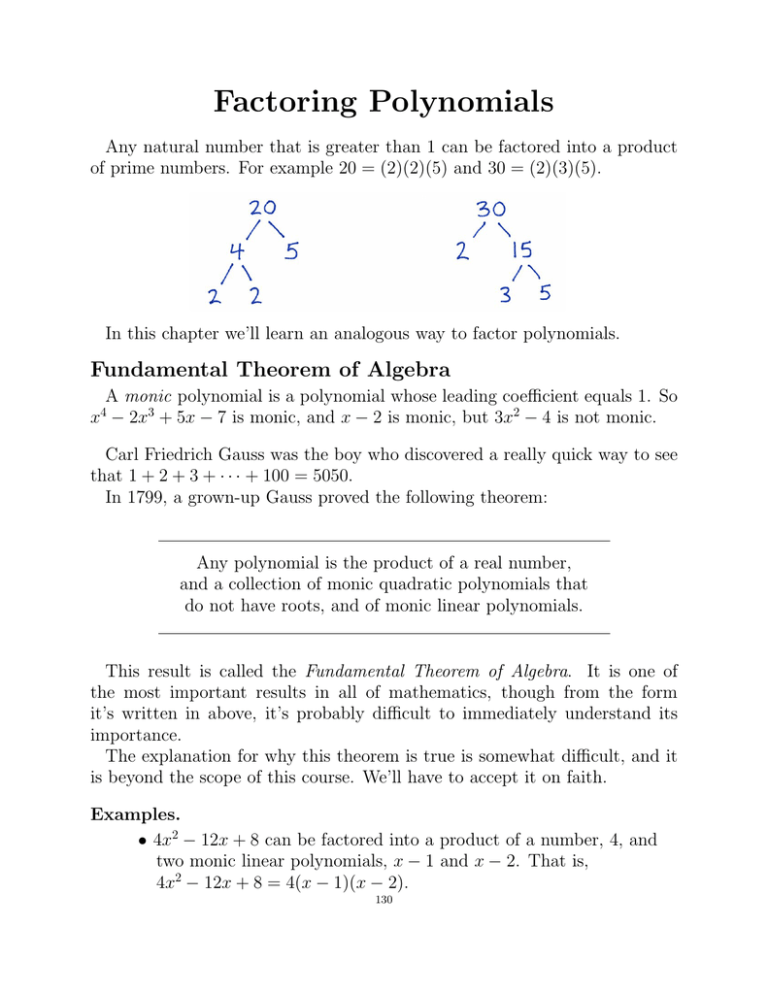
Factoring
FactoringPolynomials
Polynomials
Any
natural
number
that
is greater
than
1 can
be be
factored
into
a product
Any
natural
number
that
is greater
than
1 can
factored
into
a product
of of
prime
numbers.
ForFor
example
20 20
= (2)(2)(5)
andand
30 30
= (2)(3)(5).
prime
numbers.
example
= (2)(2)(5)
(2)(3)(5).
—
20
Lf.
/\
30
.5
2.
/\
22
/\
IS
/\
35
In In
this
chapter
we’ll
learn
anan
analogous
way
to to
factor
polynomials.
this
chapter
we’ll
learn
analogous
way
factor
polynomials.
Fundamental
Algebra
FundamentalTheorem
Theoremofof
Algebra
AA
monic
polynomial
is ais polynomial
whose
leading
coefficient
equals
1. 1.
So So
monic
polynomial
a polynomial
whose
leading
coefficient
equals
3
2
x − 2x2x3
++
5x5x
− 7 is7 is
monic,
and
x−
butbut
3x 3x2
− 4 is4 not
monic.
monic,
and
x 2 is2 monic,
is monic,
is not
monic.
4
—
—
—
—
Carl
Friedrich
Gauss
was
thethe
boy
who
discovered
a really
quick
way
to to
seesee
Carl
Friedrich
Gauss
was
boy
who
discovered
a really
quick
way
that
1 +1+2+
2+3+
· · ·•••+
+ 100100
==
5050.
that
3+
5050.
In In
1799,
Gauss
proved
thethe
following
theorem:
1799,a grown-up
a grown-up
Gauss
proved
following
theorem:
Any
polynomial
is the
product
of of
a real
number,
Any
polynomial
is the
product
a real
number,
and
a
collection
of
monic
quadratic
polynomials
that
and a collection of monic quadratic polynomials
that
dodo
notnot
have
roots,
and
of
monic
linear
polynomials.
have roots, and of monic linear polynomials.
This
Algebra.
Thisresult
resultis iscalled
calledthetheFundamental
FundamentalTheorem
Theoremof of
Algebra.It Itis isoneoneof of
the
themost
mostimportant
importantresults
resultsin inallallof ofmathematics,
mathematics,though
thoughfrom
fromthetheform
form
it’sit’swritten
in
above,
it’s
probably
difficult
to
immediately
understand
its
written in above, it’s probably difficult to immediately understand its
importance.
importance.
The
this
is is
true
is is
somewhat
difficult,
and
it it
Theexplanation
explanationforforwhy
why
thistheorem
theorem
true
somewhat
difficult,
and
is isbeyond
this
to to
accept
it on
faith.
beyondthe
thescope
scopeof of
thiscourse.
course.We’ll
We’llhave
have
accept
it on
faith.
Examples.
Examples.
2
• •4x4x2
− 12x
+ +8
8 can
factored
12x
canbebe
factoredinto
intoa
two
monic
two
moniclinear
linearpolynomials,
polynomials,x −
x 1
2
4x4~2_
− 12x
+ 8 = 4(x − 1)(x − 2).
12x+8=4(x—1)(x—2).
—
—
130
130
product
a number,
4, 4,
and
a productof of
a number,
and
and
x
−
2.
That
is,
1 and x 2. That is,
—
• −x5 + 2x4 − 7x3 + 14x2 − 10x + 20 can be factored into a product
of a number, −1, a monic linear polynomial, x − 2, and two monic
quadratic polynomials that don’t have roots, x2 + 2 and x2 + 5. That
is −x5 + 2x4 − 7x3 + 14x2 − 10x + 20 = −(x − 2)(x2 + 2)(x2 + 5).
(We can check the discriminants of x2 + 2 and x2 + 5 to see that
these two quadratics don’t have roots.)
• 2x4 − 2x3 + 14x2 − 6x + 24 = 2(x2 + 3)(x2 − x + 4). Again, x2 + 3
and x2 − x + 4 do not have roots.
Notice that in each of the above examples, the real number that appears
in the product of polynomials – 4 in the first example, −1 in the second,
and 2 in the third – is the same as the leading coefficient for the original
polynomial. This always happens, so the Fundamental Theorem of Algebra
can be more precisely stated as follows:
If p(x) = an xn + an−1 xn−1 + · · · + a0 ,
then p(x) is the product of the real number an ,
and a collection of monic quadratic polynomials that
do not have roots, and of monic linear polynomials.
Completely factored
A polynomial is completely factored if it is written as a product of a real
number (which will be the same number as the leading coefficient of the
polynomial), and a collection of monic quadratic polynomials that do not
have roots, and of monic linear polynomials.
Looking at the examples above, 4(x − 1)(x − 2) and −(x − 2)(x2 + 2)(x2 + 5)
and 2(x2 + 3)(x2 − x + 4) are completely factored.
One reason it’s nice to completely factor a polynomial is because if you do,
then it’s easy to read off what the roots of the polynomial are.
Example. Suppose p(x) = −2x5 + 10x4 + 2x3 − 38x2 + 4x − 48. Written
in this form, its difficult to see what the roots of p(x) are. But after being
completely factored, p(x) = −2(x + 2)(x − 3)(x − 4)(x2 + 1). The roots of
131
this polynomial can be read from the monic linear factors. They are −2, 3,
and 4.
(Notice that p(x) = −2(x + 2)(x − 3)(x − 4)(x2 + 1) is completely factored
because x2 + 1 has no roots.)
*
*
*
*
*
*
*
*
*
*
*
*
*
Factoring linears
To completely factor a linear polynomial, just factor out its leading coefficient:
�
b�
ax + b = a x +
a
For example, to completely factor 2x + 6, write it as the product 2(x + 3).
Factoring quadratics
What a completely factored quadratic polynomial looks like will depend on
how many roots it has.
0 Roots. If the quadratic polynomial ax2 + bx + c has 0 roots, then it can
be completely factored by factoring out the leading coefficient:
�
b
c�
2
2
ax + bx + c = a x + x +
a
a
b
c
(The graphs of ax2 +bx+c and x2 + a x+ a differ by a vertical stretch or shrink
that depends on a. A vertical stretch or shrink of a graph won’t change the
number of x-intercepts, so x2 + ab x + ac won’t have any roots since ax2 + bx + c
doesn’t have any roots. Thus, x2 + ab x + ac is completely factored.)
Example. The discriminant of 4x2 −2x+2 equals (−2)2 −4(4)(2) = 4−32 =
−28, a negative number. Therefore, 4x2 − 2x + 2 has no roots, and it is
completely factored as 4(x2 − 12 x + 12 ).
2 Roots. If the quadratic polynomial ax2 + bx + c has 2 roots, we can
name them α1 and α2 . Roots give linear factors, so we know that (x − α1 )
132
and (x − α2 ) are factors of ax2 + bx + c. That means that there is some
polynomial q(x) such that
ax2 + bx + c = q(x)(x − α1 )(x − α2 )
The degree of ax2 + bx + c equals 2. Because the sum of the degrees of the
factors equals the degree of the product, we know that the degree of q(x) plus
the degree of (x − α1 ) plus the degree of (x − α2 ) equals 2. In other words,
the degree of q(x) plus 1 plus 1 equals 2.
Zero is the only number that you can add to 1 + 1 to get 2, so q(x) must
have degree 0, which means that q(x) is just a constant number.
Because the leading term of ax2 + bx + c – namely ax2 – is the product of
the leading terms of q(x), (x − α1 ), and (x − α2 ) – namely the number q(x),
x, and x – it must be that q(x) = a. Therefore,
ax2 + bx + c = a(x − α1 )(x − α2 )
Example. The discriminant of 2x2 + 4x − 2 equals 42 − 4(2)(−2) = 16 + 16 =
32, a positive number, so there are two roots.
We can use the quadratic formula to find the two roots,
before we do,
√ but �
it’s
√ best to simplify the square root of the discriminant: 32 = (4)(4)(2) =
4 2.
Now we use the quadratic formula to find that the roots are
√
√
√
−4 + 4 2 −4 + 4 2
=
= −1 + 2
2(2)
4
and
√
√
√
−4 − 4 2 −4 − 4 2
=
= −1 − 2
2(2)
4
Therefore, 2x2 + 4x − 2 is completely factored as
�
√ ��
√ �
√
√
2 x − (−1 + 2) x − (−1 − 2) = 2(x + 1 − 2)(x + 1 + 2)
1 Root. If ax2 + bx + c has exactly 1 root (let’s call it α1 ) then (x − α1 ) is
a factor of ax2 + bx + c. Hence,
ax2 + bx + c = g(x)(x − α1 )
for some polynomial g(x).
133
Because the degree of a product is the sum of the degrees of the factors,
g(x) must be a degree 1 polynomial, and it can be completely factored into
something of the form λ(x − β) where λ, β ∈ R. Therefore,
ax2 + bx + c = λ(x − β)(x − α1 )
Notice that β is a root of λ(x − β)(x − α1 ), so β is a root of ax2 + bx + c
since they are the same polynomial. But we know that ax2 + bx + c has only
one root, namely α1 , so β must equal α1 . That means that
ax2 + bx + c = λ(x − α1 )(x − α1 )
The leading term of ax2 +bx+c is ax2 . The leading term of λ(x−α1 )(x−α1 )
is λx2 . Since ax2 + bx + c equals λ(x − α1 )(x − α1 ), they must have the same
leading term. Therefore, ax2 = λx2 . Hence, a = λ.
Replace λ with a in the equation above, and we are left with
ax2 + bx + c = a(x − α1 )(x − α1 )
Example. The discriminant of 3x2 − 6x + 3x equals (−6)2 − 4(3)(3) =
36−36 = 0, so there is exactly one root. We find the root using the quadratic
formula:
√
−(−6) + 0 6
= =1
2(3)
6
Therefore, 3x2 − 6x + 3x is completely factored as 3(x − 1)(x − 1).
Summary. The following chart summarizes the discussion above.
roots of ax2 + bx + c
completely factored form of ax2 + bx + c
no roots
a(x2 + ab x + ac )
2 roots: α1 and α2
a(x − α1 )(x − α2 )
1 root: α1
a(x − α1 )(x − α1 )
134
*
*
*
*
*
*
*
*
*
*
*
*
*
Factors in Z
Recall that the factors of an integer n are all of the integers k such that
n = mk for some third integer m.
Examples.
• 12 = 3 · 4, so 4 is a factor of 12.
• −30 = −2 · 15, so 15 is a factor of −30.
• 1, −1, n and −n are all factors of an integer n. That’s because
n = n · 1 and n = (−n)(−1).
Important special case. If α1 , α2 , . . . αn ∈ Z, then each of these numbers
are factors of the product α1 α2 · · · αn . For example, 2, 10, and 7 are each
factors of 2 · 10 · 7 = 140.
Check factors of degree 0 coefficient when searching for
roots
If k, α1 , and α2 are all integers, then the polynomial
q(x) = k(x − α1 )(x − α2 ) = kx2 − k(α1 + α2 )x + kα1 α2
has α1 and α2 as roots, and each of these roots are factors of the degree 0
coefficient of q(x). (The degree 0 coefficient is kα1 α2 .)
More generally, if k, α1 , α2 , . . . , αn ∈ Z, then the degree 0 coefficient of the
polynomial
g(x) = k(x − α1 )(x − α2 ) · · · (x − αn )
equals kα1 α2 · · · αn . That means that each of the roots of g(x) – which are
the αi – are factors of the degree 0 coefficient of g(x).
Now it’s not true that every polynomial has integer roots, but many of the
polynomials you will come across do, so the two paragraphs above offer a
powerful hint as to what the roots of a polynomial might be.
135
When searching for roots of a polynomial
whose coefficients are all integers,
check the factors of the degree 0 coefficient.
Example. 3 and −7 are both roots of 2(x − 3)(x + 7).
Notice that 2(x − 3)(x + 7) = 2x2 + 8x − 42, and that 3 and −7 are both
factors of −42.
Example. Suppose p(x) = 3x4 + 3x3 − 3x2 + 3x − 6. This is a degree 4
polynomial, so it will have at most 4 roots. There isn’t a really easy way to
find the roots of a degree 4 polynomial, so to find the roots of p(x), we have
to start by guessing.
The degree 0 coefficient of p(x) is −6, so a good place to check for roots is
in the factors of −6.
The factors of −6 are 1, −1, 2, −2, 3, −3, 6, and −6, so we have eight
quick candidates for what the roots of p(x) might be. A quick check shows
that of these eight candidates, exactly two are roots of p(x) – namely 1 and
−2. That is to say, p(1) = 0 and p(−2) = 0.
*
*
*
*
*
*
*
*
*
*
*
*
*
Factoring cubics
It follows from the Fundamental Theorem of Algebra that a cubic polynomial is either the product of a constant and three linear polynomials, or
else it is the product of a constant, one linear polynomial, and one quadratic
polynomial that has no roots.
In either case, any cubic polynomial is guaranteed to have a linear factor,
and thus is guaranteed to have a root. You’re going to have to guess what
that root is by looking at the factors of the degree 0 coefficient. (There is
a “cubic formula” that like the quadratic formula will tell you the roots of
a cubic, but the formula is difficult to remember, and you’d need to know
about complex numbers to be able to use it.)
Once you’ve found a root, factor out the linear factor that the root gives
you. You will now be able to write the cubic as a product of a monic linear
136
factors of —3 are 1, —1, 3, and —3. Check these factors to see if any of them
are roots.
After checking, you’ll see that 1 is a root. That means that x —1 is a factor
of 2x3 3x2 + 4x 3. Therefore, we can divide 2x3 3x2 + 4x 3 by x 1
to get another
polynomial
and polynomial
a quadratic polynomial. Completely factor the quadratic and
polynomial
a quadratic
polynomial.
Completely
factor the quadratic and
then
you willand
have
completely
factored the
cubic.
2x3—3x2+4x—3
2
then you will have completely factored the
cubic.
=2x
—x+3
—
—
—
—
—
Problem. Completely factor 2x3 − 3x2 + 4x − 3.
Thus,
Problem.
Completely factor 2x3 3~2 + 4x 3.
Solution. Start 2x3—3x2+4x—3=(x—1)(2x2—x+3)
by guessing a root. The degree 0 coefficient is −3, and the
Solution.
Start
by−1,
guessing
root.Check
The these
degreefactors
0 coefficient
—3,ofand
the
factors of −3 are 1,
3, anda−3.
to see ifis any
them
factors
of —3 are 1, —1, 3, and —3. Check these factors to see if any of them
are
roots.
are
roots.
After
checking, you’ll see that 1 is a root. That means that x − 1 is a factor
3
3
you’ll
see that 1 we
is acan
root.
That2xmeans
x−
—13 isbya xfactor
of After
2x − checking,
3x2 + 4x −
3. Therefore,
divide
− 3x2that
+ 4x
−1
of
2x3
3x2
+
4x
3.
Therefore,
we
can
divide
2x3
3x2
+
4x
3
by
x
1
to get another polynomial
to get another polynomial
2x3 − 3x2 + 4x − 3
= 2x22− x + 3
2x3—3x2+4x—3
The discriminant of 2x2 x x−+1 3 equals=2x
(_1)2—x+3
4(2)(3) = 1 24 = —23,
a negative number. Therefore, 2x2 x + 3 has no roots, so to completely
Thus,
3 just2 have to factor out the leading
Thus,
factor 2x2 x +32xwe
as follows:
− 3x + 4x − 3 = (x − 1)(2x2 − x +coefficient
3)
2x2—x-1-3=2(x2—
~x+~).
2x3—3x2+4x—3=(x—1)(2x2—x+3)
—
—
—
—
—
—
—
—
—
—
—
—
2x3-3x1 ~~+z-3
/\
(zx2_x+3’)
(x-l)
a
2
/N
The discriminant of 2x − x + 3 equals (−1)2 − 4(2)(3) = 1 − 24 = −23,
The discriminant
2x2 x +2x32 equals
= to
1 completely
24 = —23,
a negative
number. of
Therefore,
− x + 3(_1)2
has no4(2)(3)
roots, so
2
a negative
Therefore,
+ 3thehas
no roots,
so to as
completely
factor
2x −number.
x +�3 we just
have
factor xout
leading
coefficient
follows:
� to 2x2
1
3
2
2
factor
x +3
have to factor out the leading coefficient as follows:
2x
− x2x2
+3=
2 x we
−
The
final
answer
is just
2x + 2 .
—
—
—
—
2x2—x-1-3=2(x2— ~x+~).
2(x_1)(x2_
~+~)
2x3-3x1 137
~~+z-3
/\
(zx2_x+3’)
(x-l)
a
The final answer is
The final answer is
/N
�
1
3�
2(x − 1) x − x +
2
2(x_1)(x2_ 2
2
137
137
~+~)
—
3x3—3x2—15x-I-6
=
(x+2)(3x2—9x+3)
Problem. Completely factor 3x3 − 3x2 − 15x + 6.
Problem. Completely factor 3w3 3w2 15w + 6.
—
—
Solution. The factors of 6 are {1, −1, 2, −2, 3, −3, 6, −6}. Check to see that
Solution.
TheThen
factors
of 6 arex{1,
—2,3,
—3,6, —6}. Check to see that
−2
a root.
+ 2—1,2,
to find
Theis discriminant
ofdivide
3w2 by
9w +3
equals
45,that
and thus 3w2 9w +3 has two
—2 is a root. Then divide
by 2x +2 to find that
roots and can be factored
3x3 −further.
3x − 15x + 6
2
− we
9x +
3 use the quadratic
3w3 of
3x23w2 15w9w++6 3 is= 3,3xand
The leading coefficient
can
x+2
= 3w2—9x+3
x+2of 3w2 —9w + 3 are ~ and ~ From what
formula
to check that the roots
so
so learned above about
we
we know
that
2
2
3x3 − 3xfactoring
− 15x +quadratics,
6 = (x + 2)(3x
− 9x
+ 3)3w2 9w + 3
3x3—3x2—15x-I-6
= (x+2)(3x2—9x+3)
3(w—~~”~)(x—~
V’s)
—
—
—
—
—
—
—
3x3-3x2-15i ÷≤
/\
(x+2~
(3x2_cbc.
//
3+S\
c~—2
2
/
,~i
The discriminant of 3x − 39x + 3 equals 45, and
thus 3x2 − 9x + 3 has two
The discriminant
of 3w2 further.
9w +3 equals 45, and thus 3w2 9w +3 has two
roots
and can be factored
roots
and
can becoefficient
factored further.
The
leading
of 3x2 − 9x + 3 is 3, and we
√ can use√the quadratic
The
leading
coefficient
of
3w2
9w
+
3
is
3,
and
we
can use the quadratic
3+
2
To summarize,
formula
to check that the roots of 3x − 9x + 3 are 2 5 and 3−2 5 . From what
formula
to check
that
the roots
of 3w2
—9w + 3 are
~ and ~2 From what
we learned
above
about
factoring
quadratics,
we
know that 3x − 9x + 3 =
√
√
3w3 3w2 about
15w
+ 6 = (w + 2)(3w2 9w + 3)
we learned
9w + 3
3+ 5above 3−
5 factoring quadratics, we know that 3w2
3(x − 2 )(x − 2 ).
3(w—~~”~)(x—~ V’s)
I
3+~/~~i
3—Vg
=(w-i-2)3~çw—
2 )çw—
2
3x3-3x2-15i ÷≤
—
—
—
—
—
—
/
=3(w+2)~w—
/\
(x+2~
—
3+v’g’~,i
2 )k~X—
3—’~./~
2
(3x2_cbc.
//
3
3+S\,~i
c~—2
/
To summarize,
To summarize,
3x3 − 3x2 − 15x + 6 = (x + 2)(3x2 − 9x + 3)
3w3 3w2 15w + 6 = (w + 2)(3w2 9w + √
3)
√
�
3 + 5 ��
3 − 5�
= (x + 2)3I x −3+~/~~i x −3—Vg
=(w-i-2)3~çw—
2 2√ )çw—
2 2√
�
��
3+ 5
3 − 5�
= 3(x + 2)/ x −3+v’g’~,i x −3—’~./~
=3(w+2)~w—
2 2 )k~X—
22
—
—
—
138
—
Factoring quartics
Degree 4 polynomials are tricky. As with cubic polynomials, you should
begin by checking whether the factors of the degree 0 coefficient are roots. If
one of them is a root, then you can use the same basic steps that we used
with cubic polynomials to completely factor the polynomial.
The problem with degree 4 polynomials is that there’s no reason that a
degree 4 polynomial has to have any roots – take (x2 + 1)(x2 + 1) for example.
Because a degree 4 polynomial might not have any roots, it might not have
any linear factors, and it’s very hard to guess which quadratic polynomials
it might have as factors.
*
*
*
*
*
*
*
139
*
*
*
*
*
*
Exercises
Completely factor the polynomials given in #1-8
1.) 10x + 20
2.) −2x + 5
3.) −2x2 − 12x − 18
4.) 10x2 + 3
5.) 3x2 − 10x + 5
6.) 3x2 − 4x + 5
7.) −2x2 + 6x − 3
8.) 5x2 + 3x − 2
9.) Find a root of x3 − 5x2 + 10x − 8.
10.) Find a root of 15x3 + 35x2 + 30x + 10.
11.) Find a root of x3 − 2x2 − 2x − 3.
Completely factor the polynomials in #12-16.
12.) −x3 − x2 + x + 1
13.) 5x3 − 9x2 + 8x − 20
14.) −2x3 + 17x − 3
15.) 4x3 − 20x2 + 25x − 3
16.) x4 − 5x2 + 4
17.) How can the Fundamental Theorem of Algebra be used to show that
any polynomial of odd degree has at least one root?
140
